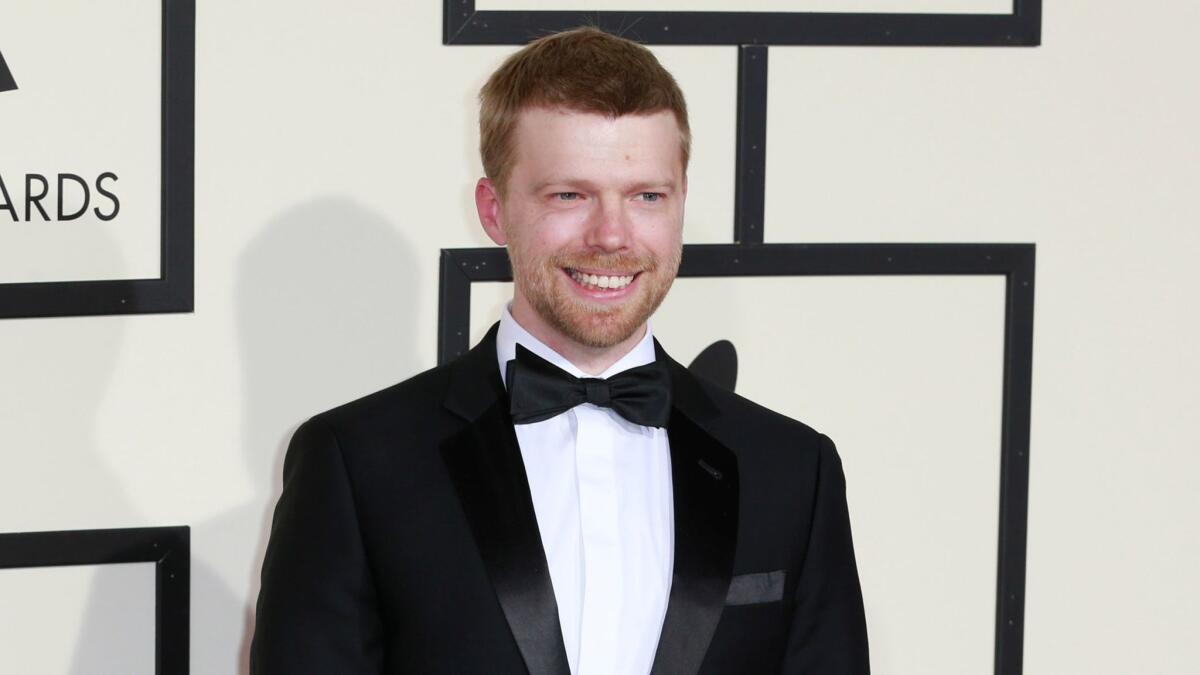Review: Andrew Norman charts a new âTrip to the Moonâ for Disney Hall

March at Walt Disney Concert Hall opened Friday night with a big-thinking Los Angeles Philharmonic extravaganza: Andrew Normanâs first opera, âA Trip to the Moon,â as staged by the L.A. Philâs inventive artist-collaborator Yuval Sharon.
But then again, February also started out big, when the orchestra presented Leonard Bernsteinâs âMassâ staged by Elkhanah Pulitzer. So will April, when Sharon returns to stage Mahlerâs âDas Lied von der Erde.â We could get used to this.
âA Trip to the Moonâ had its world premiere in Berlin in June, followed by a performance at the Barbican in London in July. Since then, Norman has been rewriting and trimming the piece. The Berlin performance reportedly lasted 70 minutes; the L.A version clocked in at 51 ½ minutes. So while the L.A. Phil billed the performance as a U.S. premiere, it really was the world premiere of the current version, and Norman says heâs not through revising it.
That may not be necessary. âA Trip to the Moonâ was delightfully entertaining as is, combining todayâs technology with the antique look of the Georges MĂŠliès 1902 science fiction silent film of the same name that partly inspired the piece. A strong colorful score that trusts listeners young and old to go wherever it roams â even into avant-garde territory with sliding strings and dissonances â and often achieves an ecstatic frenzy.
The story involves astronomers from Jules Verneâs time who blast off for the moon, are stranded there for a while, encounter strange yet ultimately lovable humanoid moon residents and learn to coexist with them before heading back to Earth. MĂŠliès appears, sung by tenor Peter Tantsits, as one of the visiting Earthlings.
The astronomersâ lines are all spoken, and the moon people sing in âMoonish,â an all-vowels language that Norman invented. I get the feeling that Norman is deliberately poking fun at opera in general for the unintelligible diction that often goes with the form.
Sharonâs whiz-bang production projected the lunar landscape on a scrim with the live-action cast to the screenâs left and right superimposed upon the landscape in real time.
About 250 professional and amateur performers â including the Los Angeles Master Chorale, Los Angeles Childrenâs Chorus, Hoover Street Elementary School Chorus and members of the L.A. Philâs Youth Orchestra Los Angeles â were situated all over the hall, many wielding Boomwhackers (tuned percussion tubes). Some of the moon folk twirled whirly tubes â Peter Schickele (a.k.a. PDQ Bach) called it the âlasso dâamoreâ â which made ethereal whining sounds that coalesced harmoniously with the music.
Not the least of all of this was the impressive L.A. Phil subscription season debut of Teddy Abrams, the enterprising 30-year-old music director of the Louisville and Britt Festival orchestras, who worked up a sweat conducting with wide swinging gestures.
He tirelessly followed Normanâs opera with an excellent, well-paced rendition of Gustav Holstâs âThe Planets,â which had the expected Abrams energy but also a properly slow, brooding âSaturnâ passage and a âNeptuneâ with just the right long choral fade at the close. Watch this guy; heâs going places.
Although there were only two performances of âA Trip to the Moonâ for the adults, next week the L.A. Phil is staging four performances for 7,000 third-, fourth- and fifth- graders.
See all of our latest arts news and reviews at latimes.com/arts.
ALSO
The week ahead in classical music
Olafur Eliassonâs new L.A. âReality projectorâ
The gold in John WIlliamsâ 45 Oscar losses
More to Read
The biggest entertainment stories
Get our big stories about Hollywood, film, television, music, arts, culture and more right in your inbox as soon as they publish.
You may occasionally receive promotional content from the Los Angeles Times.










